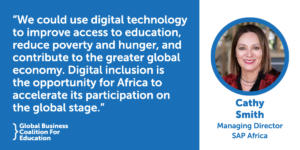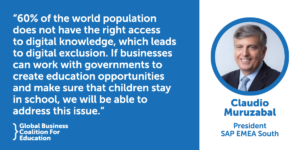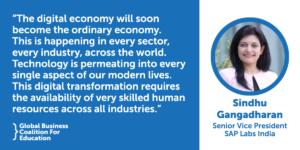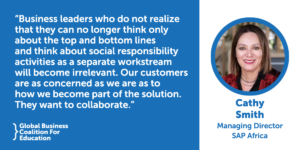Tackling the Digital Divide: A Discussion with SAP

Our Executive Director, Justin van Fleet, recently spoke with Cathy Smith, Managing Director for SAP Africa, Claudio Muruzabal, President of SAP EMEA South and Chairman of SAP Latin America and the Caribbean, and Sindhu Gangadharan, Senior Vice President and Managing Director, SAP Labs India, about how business can tackle the widening digital divide for young people.Here is an extract of the conversation that touched upon education and workforce challenges in three markets and how businesses can connect social impact to the bottom line.
What does digital inclusion mean to you?

Cathy Smith: Digital Inclusion means access to digital technology for every single person on the planet. Through access to digital technology, people can access education, earn a living, and participate in economies and growth. Access to digital technology has exploded in recent years in Africa, which presents a great opportunity for digital transformation. We could use digital technology to improve access to education, reduce poverty and hunger, and contribute to the greater global economy. Digital inclusion is the opportunity for Africa to leapfrog its engagement on the global stage.
Claudio Muruzabal: To me, digital inclusion is about creating sustainability in the long run. The more we can do to create opportunities for young people to embrace digital literacy, the more we can create a better future for them, for their families, and for their communities. This is all about education which has a multiplier effect for the future of this youth, this family, and the population overall.
Sindhu Gangadharan: India has also enjoyed an accelerated expansion of its digital infrastructure, but this digital technology is not equally accessible across the country and among every young person. There are more than 300 million young people in India, which is equivalent to the population of the United States. 200 million are old enough to enter the workforce and urgently need employable skills and competencies. The question is really about how you embrace them to make sure that they don’t fall into a kind of digital isolation.
What educational challenges and opportunities do you see in your region?
Sindhu Gangadharan: In addition to the fast growth of the youth population and the digital gap between rural and urban areas in India, the other challenge is the number of girls who do not even have access to education. There are currently 20 million girls who are denied access to education in the country. These are some difficult challenges but also some great opportunities to drive inclusion and economic growth.
Cathy Smith: Africa has a very young population, which is its greatest asset but also the reason why we need to pay more attention to education. We need to look at ways to collaborate with governments and the private sector to develop solutions. Technology can help accelerate access to education. Recent lockdowns have widened the gap between those who have and those who don’t. In Africa, every year 10 to 12 million young people enter the work market, but only three million new jobs are created. There is no better motivation to innovate than when you have a problem. People are currently trying to jointly figure out how to take a problem and make it work, and this is when we see the most incredible development happening, particularly in education and of course financial inclusion.
Claudio Muruzabal: One particularly important issue is the problem of children dropping out of school, and how do we keep students in school. It is already difficult to get children to come to school especially in marginalized communities, but it is a bigger task to make sure that they don’t leave school. About 42% of school-age children in Africa will leave school early. There is also the problem of the marginalization of girls and how through education we can create opportunities moving forward. Finally, 60% of the world population does not have the right access to digital knowledge, which leads to digital exclusion. If businesses can work with governments to create education opportunities and make sure that children stay in school, we will be able to address this issue.
Why is SAP involved in addressing this digital divide?
Sindhu Gangadharan: Since the pandemic struck us, one of the key conversations we have constantly had is how can we best support our customers in their digital transformation. The digital economy will soon become the ordinary economy. This is happening in every sector, every industry, across the world. Technology is permeating into every single aspect of our modern lives. This digital transformation requires the availability of very skilled human resources across all industries. As a responsible corporate partner, we work with many organizations to ensure that this digital transformation is inclusive and contributes to equitable growth. We need to make sure that technology is available for everybody out there. It’s about the livelihood of people, which drives the growth and the economy, and drives nations forward.
Can social impact have a business impact?
Claudio Muruzabal: You could think that caring about people is just altruism. It is, but it is also about good business. If you are having an impact on your community, large or small, you are making a tangible contribution to business, which makes these businesses more sustainable in the long run. When we talk about sustainability, most people think that we are talking about climate change and carbon emissions. I am talking about generating a space in business that makes businesses more resilient to be able to adapt to the changes the world is generating, and at the same time creating opportunities for our population, for our youth, for our kids. Social impact or business impact is a shared responsibility. It’s about understanding what is at stake and why it is as important to businesses as it is to governments to embrace the concept and do something about it.
Cathy Smith: It is imperative that leaders reset their thinking about how they can make the workplace more accessible to people who are facing barriers. Business leaders who do not realize that they can no longer think only about the top and bottom lines and think about social responsibility activities as a separate workstream will become irrelevant. Our customers are as concerned as we are as to how we become part of the solution. They want to collaborate and share ideas.
Learn more about SAP’s social imapct work around the world:



